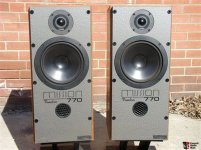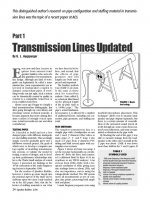in that there's an audible difference with/without the pegboard
It is going to be a quite “floppy” poorly tuned PR.
dave
P.S. I'm old enough to remember how much those perforated radiogram backs coloured the sound by rattling and resonating! 😉
GM, I found this to take away from what you have been trying to explain. Please bear in mind that I am reading from the point of someone just starting to look into these aspects and that a lot of terminology to get used toResonant air column tutorial (lots of links to follow); Sd = pipe i.d. rarely performs properly, so best to ignore such simplications: http://hyperphysics.phy-astr.gsu.edu/hbase/Waves/opecol.html#c1
Line length, taper, sets pipe fundamental; pipe area sets net volume (Vb), acoustic efficiency; adding a vent shortens the line length for a given tuning (Fb/Fp) via air mass loading
Yes, some folks use Sonotube or similar tubes or tubes within tubes to create tapered TLs
Anyway, lots to learn if wanting to properly design these types of speaker alignments.
I would love to hear your thoughts on if it is possible to focus on one simplification for a plan of attack for these pioneers? A simple aim, TL type bin, "smallened" (new word, I just invented 🙂) for them. Can a two tube, i.e. body pipe and port, approach be used to figure these drivers out?
I have no argument with Randy's basic understanding, however I would regard a classic 'radiogram' enclosure such as he describes as an 'open-backed box'.
Galu, are you an aperiodic proponent? In 91, I was in year 11 in high school. Newly arrived in Sydney from Fiji. My dad was a joiner. I have always had an interest in woodwork and furniture. I saw a sideboard in an op shop. This thing had a record player built in it and speakers! I didn't know anything about tubes and such, or had any sort of appreciation for them. Totally unaware, my music devices exposure was Walkman, ghettos and 'radios'. The 8" speakers on this thing looked huge! It was $10 and I had just enough. My buddy and I carried it home for over a 1 km. I had my very new amazing piece of tech that I bought second hand from a car boot sale, a discman! And a Marley Legend CD. The thing had a line in, so the CD plugged into that. Buffalo soldier had never sounded that good. I could hear music coated with golden glass in my ears, that's how I perceived it. Remember, I am not aware of tubes at this stage and haven't peeked inside
I think that was an HMV machine and quite wide and large. The Masonite behind each speaker bin had a grid of round holes. I remember that they were different to the main back panel. I took the back off to see if I could read anything on the speaker magnet area. It was more like what you describe for your box, rather than the type of back panel in the pic. One common back panel, three sets of holes and each speaker in its own volume. They were 8" dual cones
This thing didn't really buzz or rattle, though. It was built very solid. When we had to move, I was made to break it up and dispose of it. This wasn't easy like your typical chipboard ones
Btw they way, how do you feel about a two-step tube approach as I described to GM above?
The better quality stereograms had acoustically loaded speaker compartments that were physically separated from the electronics compartment.
I built a pair of aperiodic enclosures in the distant past to house my 12" full range Wharfedale speakers. The aperiodic loading consisting of a carefully determined series of cloth covered holes was known as a "distributed port".
I advocated such loading for your car speakers as it does not involve knowledge of their Thiele/Small parameters, and is flexible in its application.
How good my simple design would work with your drivers is a matter for experimentation.
P.S. I am not au fait with "a two-step tube approach".
I built a pair of aperiodic enclosures in the distant past to house my 12" full range Wharfedale speakers. The aperiodic loading consisting of a carefully determined series of cloth covered holes was known as a "distributed port".
I advocated such loading for your car speakers as it does not involve knowledge of their Thiele/Small parameters, and is flexible in its application.
How good my simple design would work with your drivers is a matter for experimentation.
P.S. I am not au fait with "a two-step tube approach".
Cool man, thanks for all the input on these. I take it that sealing off a TL would let me mock test a sealed box, can a bunch of straws mock aperiodic? Trying to come up with a simple way to run these through a few different box tests
I think, from all views presented, a 15L sealed box with a removable back panel and a second back panel with holes to try for sealed and aperiodic
and or
1.6 m tapered pipe for TL testing. (can this overall volume be reduced with any port trickery, recommended?). I thought I got the bit about porting a sealed pipe, but I don't think I am getting my head around this properly
I think, from all views presented, a 15L sealed box with a removable back panel and a second back panel with holes to try for sealed and aperiodic
and or
1.6 m tapered pipe for TL testing. (can this overall volume be reduced with any port trickery, recommended?). I thought I got the bit about porting a sealed pipe, but I don't think I am getting my head around this properly
can a bunch of straws mock aperiodic?
It was once a 'thing' to stuff reflex ports with straws. This introduces acoustic resistance to the flow of air in the port, prevents the bass reinforcing reflex action and emulates aperiodic loading. Such a procedure can only be hit and miss in its effect though.
Mission even did a reflec port with the straws molded in.
My first aperiodic experience was straws.
dave
My first aperiodic experience was straws.
dave
Mission even did a reflec port with the straws molded in.
The Mission 770 Freedom had a resistive port.
Attachments
What is the best way to reduce TL length? Is it as simple as using a smaller but more capable driver than current? Only asking to keep some options open
The length of a TL depends on the resonant frequency of the driver.
The higher the resonant frequency, the shorter the TL.
https://audiojudgement.com/transmission-line-speaker-design/
The higher the resonant frequency, the shorter the TL.
https://audiojudgement.com/transmission-line-speaker-design/
Does that mean that an 8" driver with 32hz fs also run 1.6 m tapered pipe and only differ in opening diameters? So 1.6 m is the length of the tapered 32hz acoustic device?
I am reading this atm. Very interesting
https://www.diyaudio.com/community/threads/an-improved-transmission-line-alignment.243483/page-6
I am reading this atm. Very interesting
https://www.diyaudio.com/community/threads/an-improved-transmission-line-alignment.243483/page-6
Simple quarter wavelength design would indicate a TL length of around 2.7 m for an Fres of 32 Hz.
However, wchang talks about a "highly tapered line" which apparently reduces the required length.
Not being an expert on TL design, I would resort to a suitable calculator. This one calculates both for 'classic tuning' and 'low tuning':
http://www.mh-audio.nl/Calculators/TML.html
EDIT: You will notice that the calculator requires you to input Sd, the loudspeaker cone area.
However, wchang talks about a "highly tapered line" which apparently reduces the required length.
Not being an expert on TL design, I would resort to a suitable calculator. This one calculates both for 'classic tuning' and 'low tuning':
http://www.mh-audio.nl/Calculators/TML.html
EDIT: You will notice that the calculator requires you to input Sd, the loudspeaker cone area.
Last edited:
The length of a TL depends on the resonant frequency of the driver.
As well a taper that goes from big to small will be shorter than a straight line which wil be shorter than a Voigt. And a Mass-Loaded ternimus allows for at least some shortening of the line.
And then like any other loudspeaker the specific Fs, Qts, Vas of the driver used.
dave
I am reading this atm. Very interesting
https://www.diyaudio.com/community/threads/an-improved-transmission-line-alignment.243483/page-6
I don’t think your link is taking me to the place you intend.
As far as that thread goes, they are, poorly, giung over fairly well-known territory.
To get close to a decent design one should really sim the line with a proper modeler. It is not just Fs, but also Qts, Vas, your design goals, and the kit you use it with to a lesser extent.
There are a huge number of variables and you are unlikely to get anywhere by pen & paper. Even a good modeler has to be in the hands of someone who understands what they are doing.
dave
I would resort to a suitable calculator.
And the mh-audio calc;ator is not one of them. It simply follows the classical recipe (https://www.t-linespeakers.org/design/classic.html, note the comment in red), which will give you a VERY low chance of something optimum.
I would stay away from that thing, it wil warp your understanding.
EDIT: You will notice that the calculator requires you to input Sd, the loudspeaker cone area.
A more or less meaningless spec when designing a TL, or any box for that matter (other than having to fit the driver on the baffle),
dave
I originally wrote in post #52 that driver diameter didn't influence the length of the TL - but went and edited it out!
However I did mention the length reduction effect of a suitable taper.
Thanks for your explanations, Dave. Like Randy, I'm learning all the time!
However I did mention the length reduction effect of a suitable taper.
Thanks for your explanations, Dave. Like Randy, I'm learning all the time!
I think, from all views presented, a 15L sealed box with a removable back panel and a second back panel with holes to try for sealed and aperiodic
Given the number of variables associated with the design of a transmission line enclosure, I think the above is the more practical option.
My first real speaker build was a Radford S90 clone using Philips drivers where built in 1975. I have learned a lot since then. And MJKs work (and Augspergers independent verification) in 1999 dramatically changed TL design space. I was lucky enuff to be prepping Martin’s first on-line work at the same time i heard Augsperger’s presentation at AES 1999 in NYNY.
dave
dave
- Home
- Loudspeakers
- Multi-Way
- Desktop TL template audio discussion

